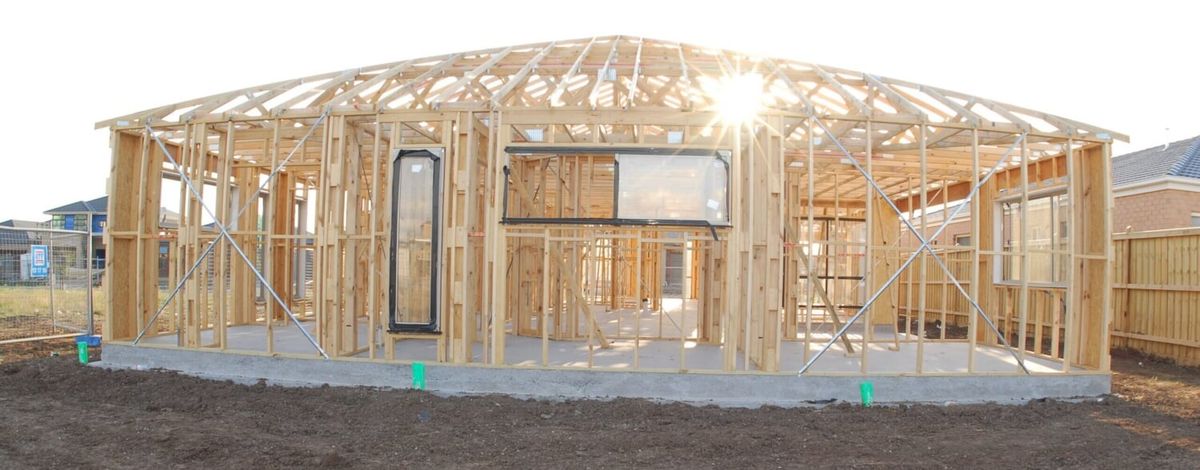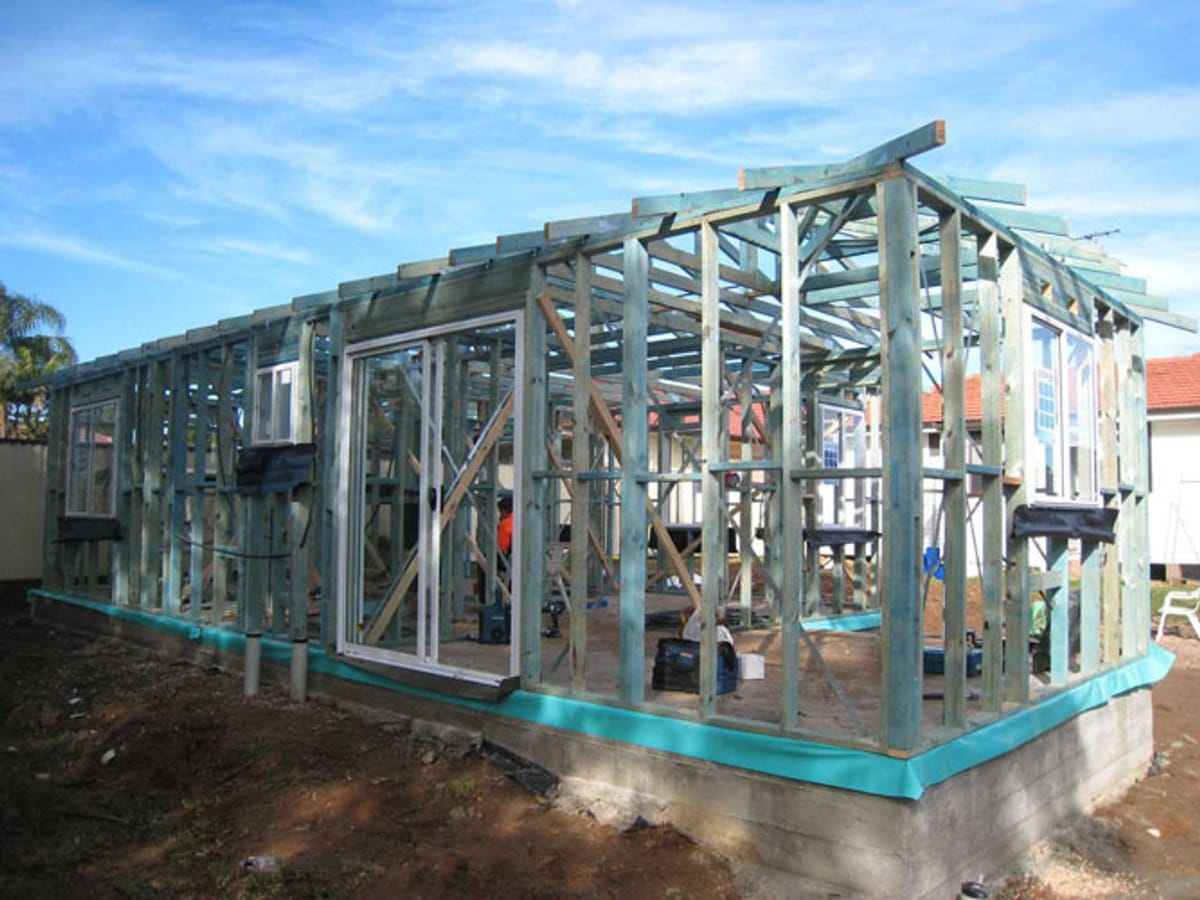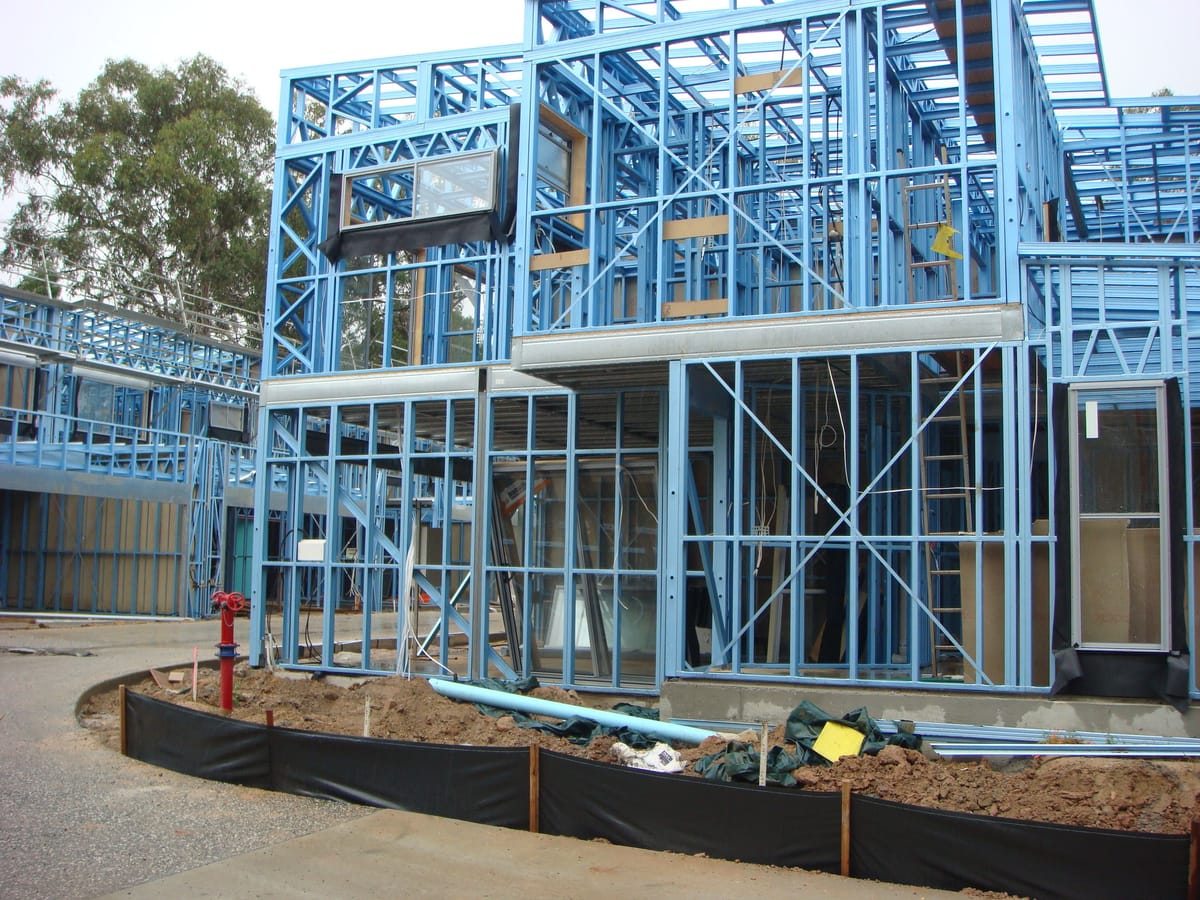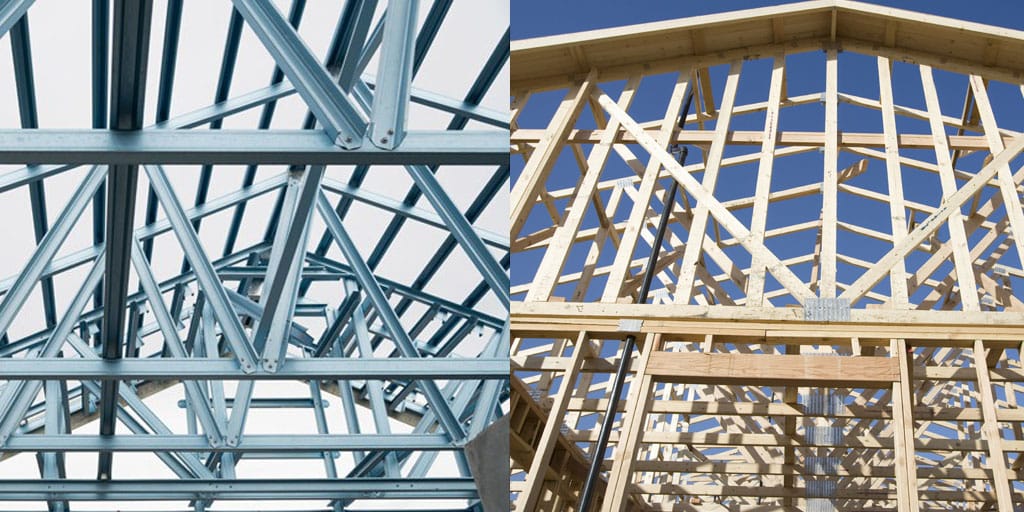Take The Quiz On This Post
Read the post, then take the quiz—test your knowledge and see what you’ve learned!
Introduction
Termites, often referred to as white ants, are a significant threat to Australian homes. These tiny eusocial insects are capable of causing substantial damage to wooden structures, often without homeowners realising it until it’s too late.
Eusociality (Greek εὖ eu "good" and social) is the highest level of organisation of sociality. It is defined by the following characteristics: cooperative brood care (including care of offspring from other individuals), overlapping generations within a colony of adults, and a division of labour into reproductive and non-reproductive groups.
Ref: Wikipedia
In fact, termites are responsible for more damage to Australian homes than fires, floods, and storms combined, with an estimated one in five homes being attacked by termites at some point during their lifespan. Given the warm, humid climate in many parts of Australia, particularly in coastal regions, termites thrive, making termite protection an essential consideration for any homeowner or prospective homebuyer.
Purpose of this post
In this blog post our aim is to provide you with a good understanding of the different types of termite barrier systems available. We will explore both physical and chemical barriers, discussing their pros, cons, and the best application areas for each.
Whether you’re building a new home or looking to protect an existing property, understanding these systems is important for making an informed decision that can save you from costly repairs in the future.
Importance of Choosing the Right Barrier
Choosing the right termite barrier system is not just a matter of compliance with building codes; it’s about safeguarding your home against one of the most destructive pests in Australia. The right barrier can prevent termites from gaining access to your home, thereby preserving the structural integrity of your property and maintaining its value.
What Are Termite Barrier Systems?
Termite barrier systems are designed to prevent termites from entering a building and causing structural damage. These systems act as a physical or chemical obstacle, blocking the subterranean termites' path to your home’s foundation or wooden structures. Termite barriers are typically installed during the construction of new buildings, but they can also be retrofitted in existing homes to provide additional protection.
The primary purpose of these barriers is to stop termites before they can enter your home. Given the stealthy nature of termites, which often go undetected until significant damage has been done, these barriers play an important role in early prevention.
Comparison of Physical and Chemical Barriers
There are two main types of termite barrier systems: physical barriers and chemical barriers. Each type works differently and has its own set of advantages and disadvantages.
- Physical Barriers: These barriers are constructed from materials that termites cannot penetrate, such as stainless steel mesh, graded stone, or concrete slabs. Physical barriers are often preferred in new constructions where they can be integrated into the building’s foundation. They offer a long-lasting solution with minimal maintenance, although they may require professional installation.
- Chemical Barriers: Chemical barriers involve the application of termiticides around the perimeter of a home or under its foundation. One of the most advanced forms of chemical barriers is the reticulated chemical system, which uses a network of pipes to deliver termiticide uniformly around the property. Chemical barriers are particularly useful in areas with high termite activity or where physical barriers are not feasible. However, they require ongoing maintenance and periodic reapplication to remain effective.
Types of Termite Barrier Systems
In this section, we will explore the various types of termite barrier systems, including both physical and chemical options. Each system has its own unique method of operation, advantages, and ideal application areas.
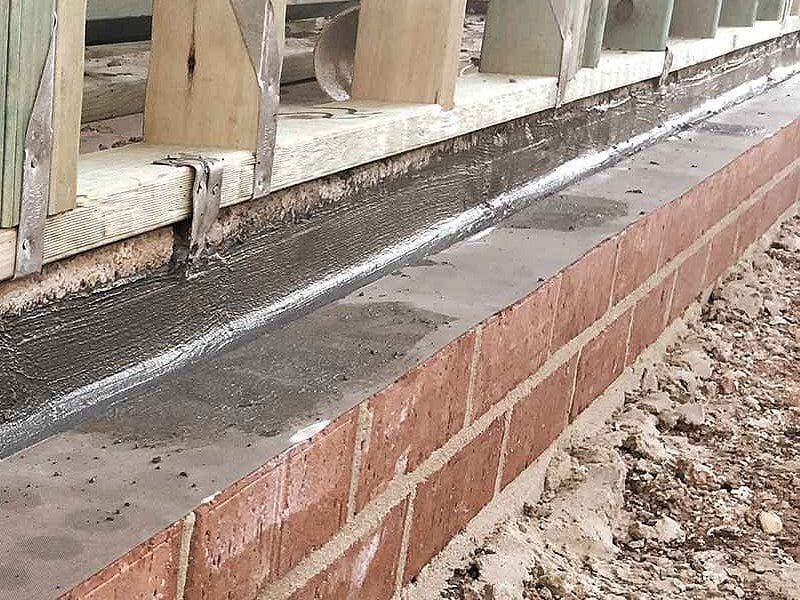
A. Stainless Steel Mesh Systems
How They Work: Stainless steel mesh systems are a type of physical termite barrier that relies on a fine, corrosion-resistant mesh to prevent termites from entering a building. The mesh is typically installed during construction, either under the foundation, against the edge beam or around vulnerable points such as service penetrations (sewer/stormwater/electrical/pipework). The mesh’s openings are too small for termites to squeeze through, effectively blocking their path.
Pros:
- Durability: Stainless steel is highly durable and resistant to corrosion, ensuring a long lifespan.
- Low Maintenance: Once installed, these systems require little to no maintenance, making them a convenient option for homeowners.
- Environmentally Friendly: Since no chemicals are used, stainless steel mesh systems are an environmentally safe choice.
Cons:
- Higher Initial Cost: The cost of materials and installation can be higher compared to other types of barriers.
- Complex Installation: Proper installation requires expertise, which can add to the overall cost and complexity of the project.
- Sharp: Protruding mesh is razor sharp and can easily cut skin.
- Untidy in areas: corners where the mesh overlap, depending on the quality of the installer, can be unsightly looking like a steel taco of sorts 😺
Best Application Areas: Stainless steel mesh systems are particularly well-suited for high-risk areas, such as coastal regions where termites are prevalent. They are also ideal for homeowners who prioritise long-term, maintenance-free solutions.
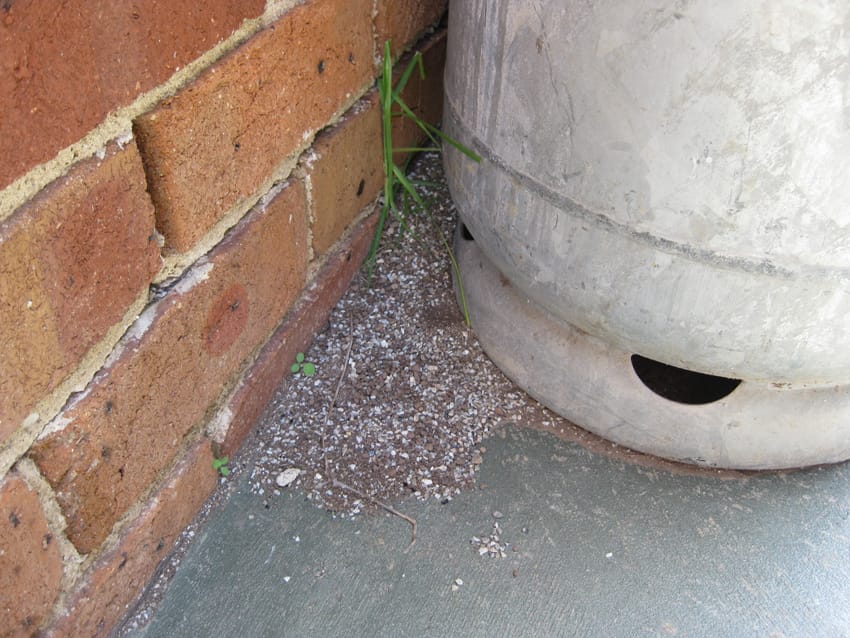
B. Graded Stone Barriers
How They Work: Graded stone barriers, also known as aggregate barriers, consist of a layer of small, precisely graded stones placed around the foundation of a building. The stones are too heavy (apparently) for termites to move and too large for them to navigate through, effectively preventing them from reaching the structure.
Pros:
- Cost-Effective: Graded stone barriers are generally less expensive to install than other types of physical barriers.
- No Chemicals Required: These barriers are an environmentally friendly option, as they do not rely on chemicals to repel or kill termites.
- Low Maintenance: Once installed, they require minimal maintenance, unless the black ants remove installed produce from the wall cavity through the weep holes (photo above).
Cons:
- Installation Requires Precision: The stones must be of a specific size and properly installed to be effective, which requires expertise.
- Potential for Shifting: Over time, the stones can shift or settle, which may reduce their effectiveness unless maintained.
- Black Ants Love this Stuff!: As shown above, the black ants will remove this from the cavity to make way for their new home, thereby helping termites!
Best Application Areas: Graded stone barriers are suitable for areas with moderate termite activity, especially in regions where quality stone materials are readily available. They are also a good option for environmentally conscious homeowners who prefer non-chemical solutions, or who may have allergies to termite chemicals.
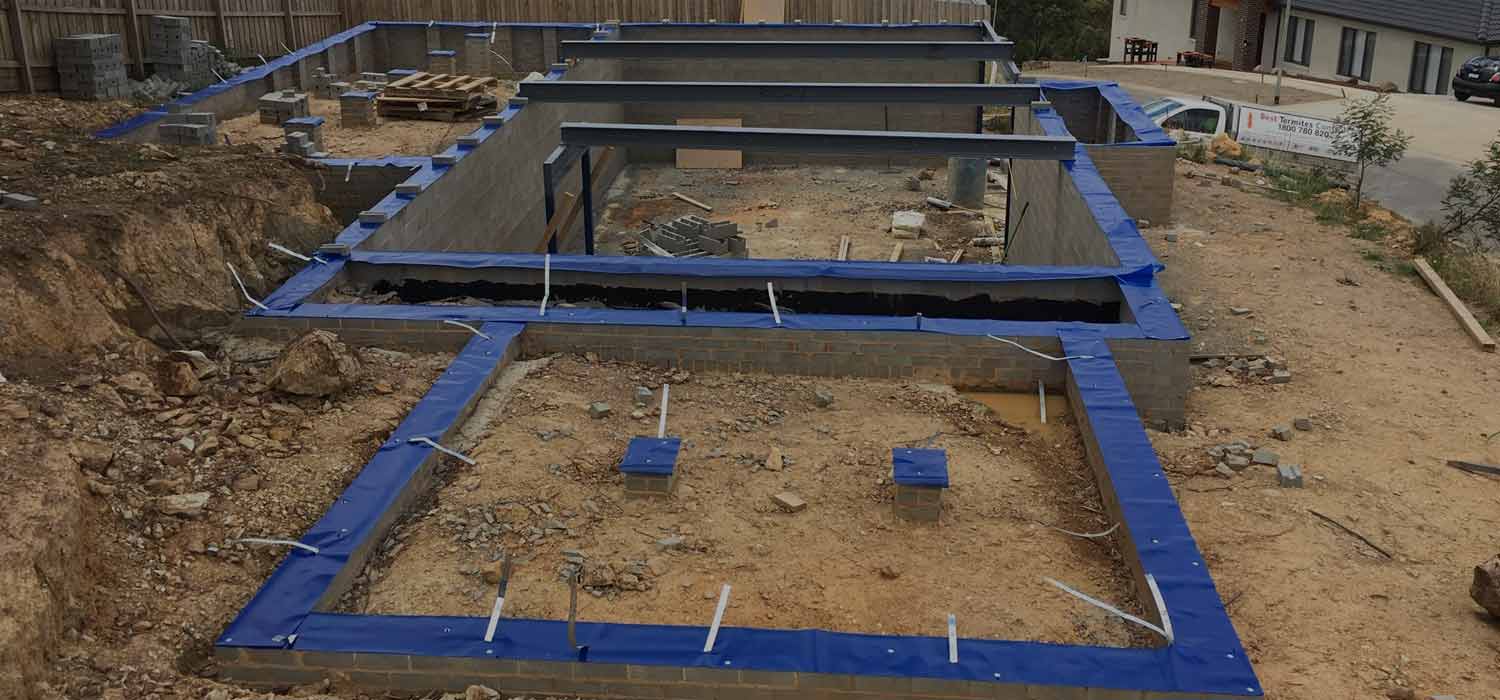
C. Physical Sheets (Polymeric Sheets)
How They Work: Polymeric sheets are durable plastic membranes that are placed under concrete slabs or around the perimeter of a foundation. These sheets act as a physical barrier, preventing termites from entering the building. They are often used in combination with other barrier systems for added protection.
Pros:
- Flexible Application: Polymeric sheets can be easily cut and shaped to fit around various structures, making them versatile.
- Complementary: They can be used alongside other termite barriers, such as chemical treatments or graded stone, to enhance protection.
- Relatively Easy Installation: Compared to some other physical barriers, polymeric sheets are relatively straightforward to install.
Cons:
- Vulnerability to Damage: During construction, the sheets can be punctured or damaged, compromising their effectiveness.
- Regular Inspection Needed: To ensure they remain effective, these barriers must be regularly inspected for any damage or wear.
Best Application Areas: Polymeric sheets are particularly effective in new constructions, especially in urban areas where the construction environment can be more controlled. They are ideal for homes where additional termite protection is needed around foundations and other vulnerable areas.
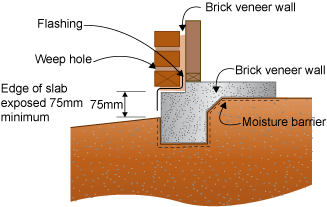
D. Concrete Slabs
How They Work: Concrete slabs can serve as both the foundation of a building and a termite barrier. When properly constructed—vibrated and free of voids or honeycombing—the slab creates a continuous physical barrier that termites cannot penetrate. For the slab to be effective, it must be free of cracks and extend beyond the perimeter of the building. Exposed slab edges, which provide a 75mm visual barrier, can also function as a form of termite protection. However, this method relies primarily on regular inspections as a defence strategy, which we believe is not the most reliable approach. Homeowners are often busy, and it’s always best to install a physical barrier that doesn’t depend solely on ongoing maintenance to preserve its integrity.
Pros:
- Dual Purpose: Concrete slabs provide both a solid foundation and an effective termite barrier.
- Long Lifespan: Properly constructed concrete slabs can last for decades without requiring significant maintenance.
- Low Maintenance: Once in place, the slab requires little to no ongoing maintenance.
Cons:
- Susceptibility to Cracks: If the slab cracks, it can create entry points for termites, reducing its effectiveness.
- Requires Professional Installation: To ensure the slab serves as an effective barrier, it must be installed by professionals who understand the specific requirements for termite protection.
Best Application Areas: Concrete slabs are best suited for new constructions where the slab is an integral part of the building design. They are particularly effective in areas where termites are known to be a significant problem, and where a long-lasting, low-maintenance solution is desired.
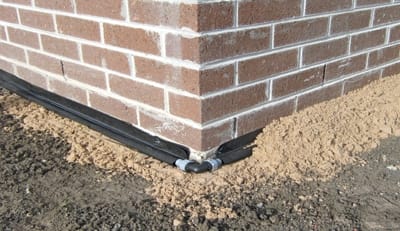
E. Chemical Barriers (Reticulated Chemical System)
How They Work: The reticulated chemical system is a modern approach to chemical termite barriers. It consists of a network of pipes installed around the foundation or under the slab of a building. These pipes deliver a termiticide, creating a chemical barrier that repels or kills termites attempting to enter the structure. The system can be recharged periodically, ensuring ongoing protection.
Pros:
- Highly Effective: The termiticide creates a strong barrier against termites, providing immediate and ongoing protection.
- Replenishable: The system can be recharged without disrupting the building or landscape, allowing for continued effectiveness over time.
- Versatile: Can be installed in both new and existing structures, making it a flexible option for termite control.
Cons:
- Maintenance Required: The chemical levels in the system need to be monitored and recharged periodically to maintain effectiveness. If the perforations in the delivery pipework become enclosed by clay, concrete, or other non-drainable materials, the system's effectiveness can be compromised due to restricted chemical movement into the surrounding soil.
- Use of Chemicals: Some homeowners may be concerned about the use of chemicals around their home, particularly if they have children or pets.
- Initial Installation Cost: While effective, the installation of a reticulated system can be costly, especially when added to an existing structure.
Best Application Areas: Reticulated chemical systems are suitable for both new and existing homes, especially in areas with high termite activity where physical barriers alone may not suffice. They are ideal for homeowners looking for a robust and long-lasting termite protection solution, with the flexibility to maintain it over time.
F. Chemical Impregnated Barriers (e.g., Kordon)
How They Work: Chemical impregnated barriers, such as Kordon, combine the physical barrier properties of materials like geotextiles with the chemical protection offered by termiticides. These barriers are typically installed during construction, where they are placed around critical areas like the perimeter, under slabs, and around service penetrations. The geotextile material is impregnated with a termiticide, which repels and kills termites that come into contact with it, providing both a physical and chemical defense.
Pros:
- Dual Protection: Combines physical and chemical barriers in one product, offering enhanced protection against termites.
- Long-Lasting: The chemical within the barrier remains active for many years, providing ongoing protection without the need for frequent reapplication.
- Ease of Installation: Can be installed during the normal course of construction without requiring significant changes to the building process, installed to pipe penetrations and to the slab edge before wall frames are installed.
- Environmental Safety: Products like Kordon are designed to minimize the environmental impact, with the termiticide contained within the geotextile to reduce the risk of chemical leaching.
Cons:
- Initial Cost: Chemical impregnated barriers can be more expensive than some other termite protection options, particularly if used extensively throughout the structure.
- Reliance on Installation Quality: The effectiveness of the barrier is highly dependent on proper installation. Any gaps or breaches can compromise its ability to protect the home.
- Limited Availability: Depending on the region, finding suppliers or installers experienced with products like Kordon may be more challenging.
Best Application Areas: Chemical impregnated barriers are particularly suitable for new constructions in areas with moderate to high termite activity. They are ideal for homeowners who want a long-term, low-maintenance solution that offers both physical and chemical protection. These barriers are commonly used in residential projects across Australia, especially where a comprehensive termite management system is required.
Pros and Cons of Termite Barrier Systems
In this section, we will summarise the advantages and disadvantages of the different termite barrier systems discussed in the previous section. Understanding these pros and cons will help homeowners and builders make informed decisions based on their specific needs and circumstances.
Advantages of Physical Termite Barriers
- Long-Term Protection: Physical barriers such as stainless steel mesh, graded stone, and polymeric sheets offer long-lasting protection with minimal maintenance once properly installed.
- Environmental Safety: Physical barriers do not rely on chemicals, making them a safer choice for the environment and for households with children or pets.
- Durability: Materials like stainless steel and concrete are highly durable and can withstand the test of time, providing ongoing protection against termites.
- Minimal Maintenance: Most physical barriers require little to no maintenance after installation, offering peace of mind to homeowners who prefer a "set it and forget it" approach.
Disadvantages of Physical Termite Barriers
- Higher Upfront Costs: Physical barriers often come with higher initial costs due to the materials and professional installation required.
- Complex Installation: Proper installation of physical barriers is critical to their effectiveness, often necessitating skilled professionals, which can add to the cost and complexity of the project.
- Potential for Damage: Certain physical barriers, like polymeric sheets, can be damaged during construction, reducing their effectiveness unless carefully inspected and maintained.
Advantages of Chemical Termite Barriers
- High Effectiveness: Chemical barriers, particularly reticulated chemical systems, are highly effective in repelling and killing termites, providing immediate protection.
- Flexibility: Chemical barriers can be installed in both new and existing homes, offering a versatile solution for a wide range of applications.
- Ongoing Protection: Reticulated systems can be replenished periodically, ensuring continued protection over time without the need for disruptive re-installation.
Disadvantages of Chemical Termite Barriers
- Maintenance Requirements: Chemical barriers require ongoing maintenance, including regular inspections and recharging of the chemical levels, to maintain their effectiveness.
- Use of Chemicals: The reliance on chemicals may be a concern for environmentally-conscious homeowners, as well as those with children, pets, or sensitive individuals in the household.
- Initial Installation Cost: While they offer effective protection, chemical barriers, especially reticulated systems, can be costly to install, particularly when retrofitted to existing structures.
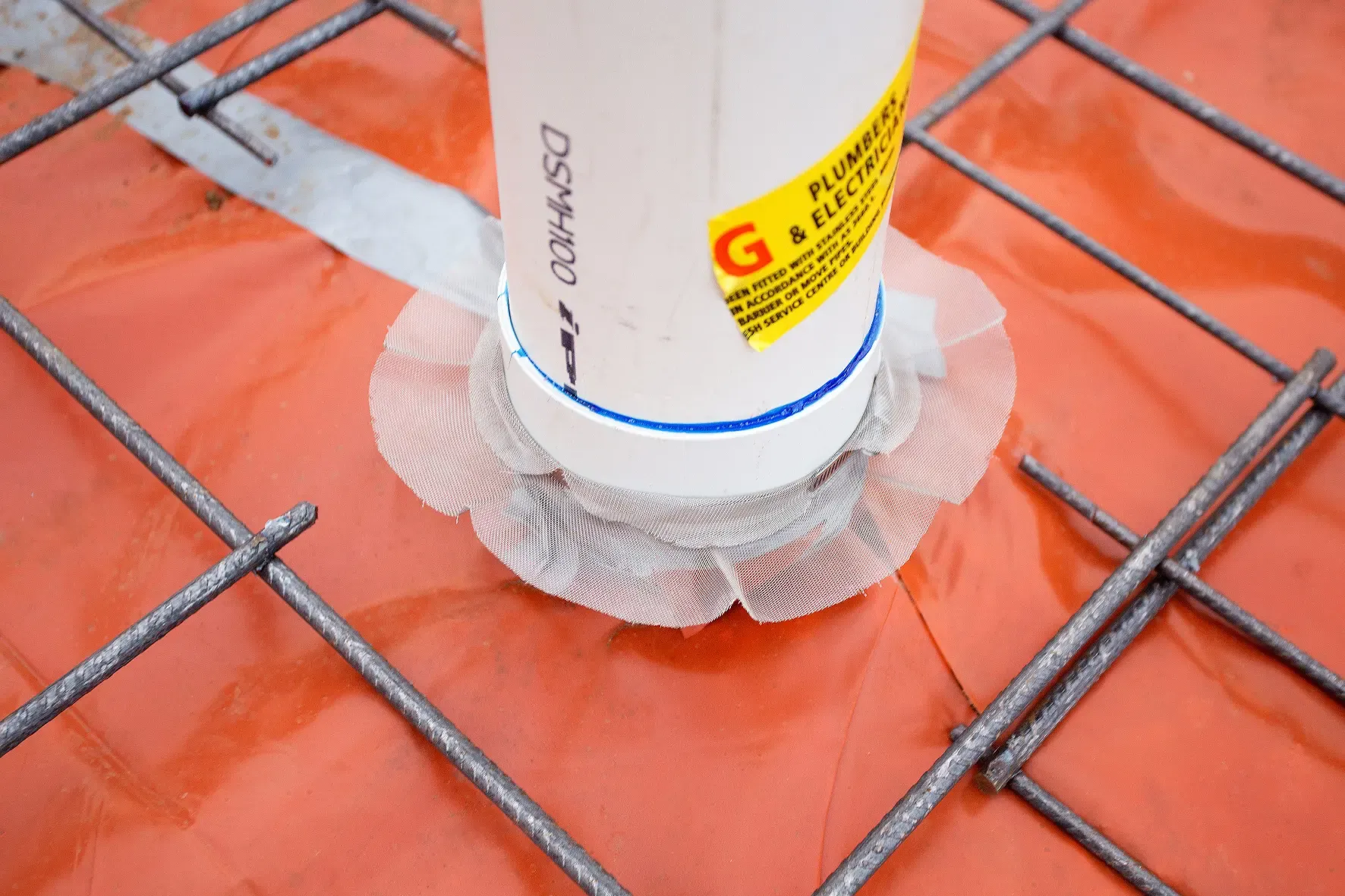
Choosing the Right Barrier System
The choice between physical and chemical termite barriers often comes down to the specific needs of the homeowner, the construction environment/site location, and the level of termite risk in the area.
- Physical barriers are ideal for new constructions where long-term, maintenance-free protection is desired, and where environmental concerns are a priority.
- Chemical barriers may be more suitable for areas with high termite activity or where retrofitting an existing structure is necessary. They offer flexibility and high effectiveness but come with the trade-off of ongoing maintenance and chemical use.
Ultimately, the decision should be based on a thorough assessment of the property, including the level of termite risk, the construction type, and the homeowner’s preferences regarding maintenance and environmental impact.
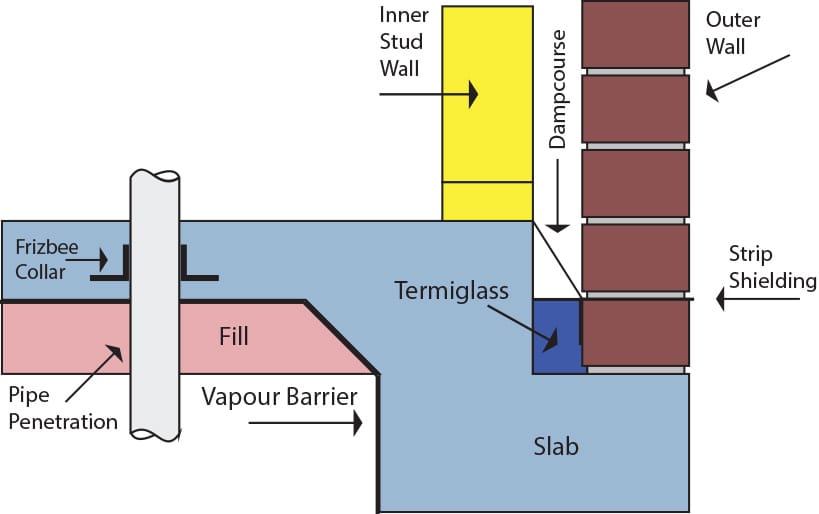
Application Areas for Termite Barrier Systems
In this section, we’ll explore the best application areas for each type of termite barrier system.
Urban vs. Rural Applications
Urban Areas:
- In urban settings, where space is often limited and construction is tightly regulated, termite barriers must be chosen carefully to comply with local building codes while providing effective protection.
- Stainless Steel Mesh Systems: These are particularly well-suited for urban environments, where they can be integrated seamlessly into the building’s design and require minimal space.
- Physical Sheets (Polymeric Sheets): Polymeric sheets are also ideal for urban areas, as they can be easily installed under slabs or around foundations in tight spaces, providing an unobtrusive barrier.
- Chemical Barriers (Reticulated Systems): Urban homes, particularly those with complex foundations or built close to other structures, may benefit from the flexibility of a reticulated chemical system, which can be installed around existing structures without major disruptions.
Rural Areas:
- Rural areas often present different challenges, such as larger plots of land, varied soil conditions, and a higher prevalence of termites.
- Graded Stone Barriers: These barriers are a cost-effective option for rural properties, where access to quality stone materials is easier and where there is ample space for installation.
- Concrete Slabs: In rural settings, concrete slabs provide a robust foundation that can double as a termite barrier, particularly in areas where the ground may be prone to shifting or where termite activity is high.
- Chemical Barriers (Reticulated Systems): For rural properties with extensive termite activity, a reticulated chemical system offers a strong line of defence, particularly in areas where physical barriers may not provide complete coverage.
High-Risk Areas
Coastal Regions:
- Coastal areas in Australia are known for their high termite activity due to the warm and humid climate. Homes in these regions require the most robust termite protection available.
- Stainless Steel Mesh Systems: Highly resistant to corrosion and damage, stainless steel mesh is ideal for coastal homes where salt and moisture can otherwise compromise other barrier types.
- Chemical Barriers (Reticulated Systems): The flexibility and replenishment capability of reticulated systems make them a strong choice for high-risk coastal areas, ensuring continuous protection against termites.
Tropical and Subtropical Regions:
- In tropical and subtropical regions, the constant threat of termites means that homeowners must be particularly vigilant.
- Physical Sheets (Polymeric Sheets): These can be used effectively in conjunction with other barriers to provide comprehensive protection in regions with year-round termite activity.
- Graded Stone Barriers: In areas where the climate allows, graded stone barriers provide a natural, chemical-free solution that can withstand the harsh conditions of tropical climates.
Bushland and Forested Areas:
- Homes built near bushland or forests are at an increased risk of termite infestation due to the proximity of natural termite habitats.
- Concrete Slabs: A well-constructed concrete slab can offer substantial protection for homes in these areas, especially when combined with other termite management systems.
- Chemical Barriers (Reticulated Systems): For homes surrounded by bushland, the ability to periodically replenish the chemical barrier without disturbing the environment is a significant advantage.
Integration with Other Termite Management Systems
Combining different termite management systems can offer enhanced protection, particularly in high-risk areas or complex construction environments.
- Physical and Chemical Barrier Combination: In regions with intense termite activity, using both a physical barrier (like stainless steel mesh) and a chemical barrier (like a reticulated system) can provide a multi-layered defence. This combination ensures that even if one barrier is breached, the other can still provide protection.
- Maintenance and Monitoring: Regular inspections and maintenance are important when using multiple systems. Homeowners should work with pest control professionals to develop a monitoring plan that ensures all barriers remain effective.
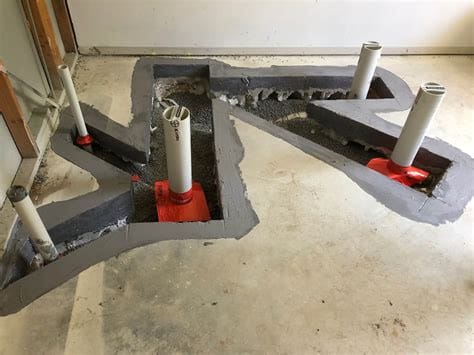
Maintaining Termite Barrier Systems
Maintenance is very important to ensure the long-term effectiveness of any termite barrier system. In this section, we’ll discuss the best practices for maintaining both physical and chemical termite barriers, common issues that may arise, and how homeowners can keep their barriers in top condition.
Regular Inspections
Importance of Regular Inspections:
- Regular inspections are essential to detect any weaknesses or breaches in your termite barrier system before termites can exploit them. Even the most robust barriers can be compromised over time due to environmental factors, construction activities, or natural wear and tear.
- Professional vs. DIY Inspections: While homeowners can perform basic checks, it’s advisable to have a licensed pest control professional conduct thorough inspections at least once a year. Professionals have the expertise to spot early signs of termite activity and identify potential vulnerabilities in the barrier system. Professionals often have thermal imaging tools and other inspection tools that make detection much easier than just a visual or tap style inspection (stick and ball, hammer, mallet).
What to Look For:
- Physical Barriers: Check for any visible damage to stainless steel mesh, polymeric sheets, or concrete slabs. Look for signs of wear, cracks, or gaps that could allow termites to pass through.
- Chemical Barriers: For reticulated chemical systems, ensure that the system is fully operational and that the chemical levels are within the recommended range. Look for any signs of leaks or blockages in the pipes.
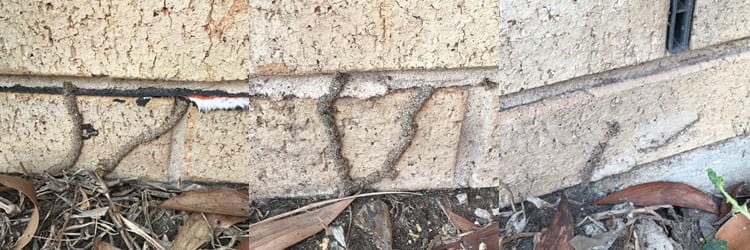
Common Maintenance Issues
Physical Barriers:
- Damage During Construction: Physical barriers like polymeric sheets and stainless steel mesh can be accidentally damaged during construction or renovations. Any damage must be repaired immediately to maintain the barrier’s effectiveness.
- Cracks in Concrete Slabs: Over time, concrete slabs can develop cracks due to settling or ground movement. These cracks can create entry points for termites. Regular inspections and prompt repair of any cracks are essential.
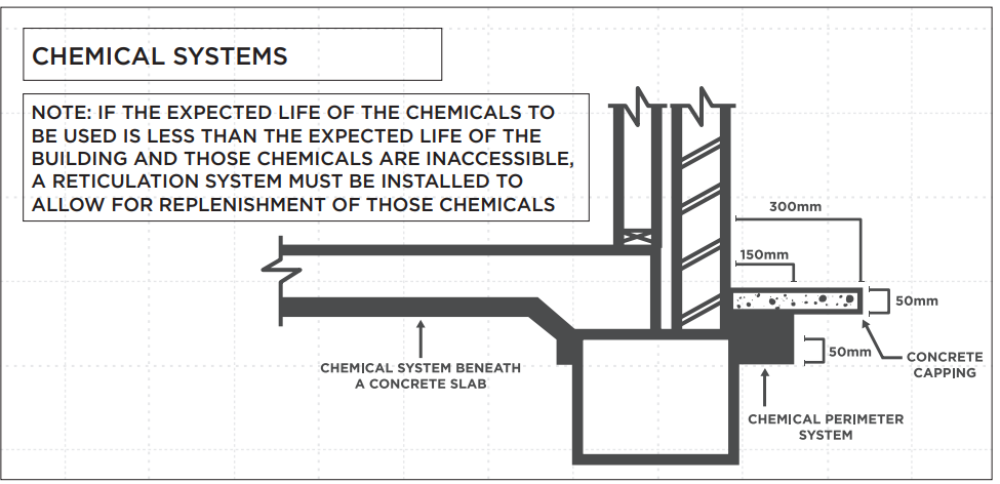
Chemical Barriers:
- Chemical Degradation: Over time, the effectiveness of the chemicals used in reticulated systems can degrade, particularly if exposed to extreme weather conditions. Regular recharging of the system is necessary to maintain a consistent level of protection.
- System Blockages: The pipes in a reticulated system can become blocked or damaged, reducing the distribution of the termiticide. Regular checks and maintenance of the system are required to ensure it functions properly.

Best Practices for Homeowners
Maintenance Tips:
- Follow Manufacturer Guidelines: Always follow the manufacturer’s guidelines for the maintenance of your termite barrier system. This includes recommended inspection intervals, recharging schedules for chemical systems, and procedures for repairing any damage.
- Keep the Perimeter Clear: Avoid piling wood, mulch, or debris against the foundation of your home, as these can provide easy access for termites. Ensure that the area around your termite barrier remains clear to prevent termites from bypassing the system.
Piling cellulose or fibrous materials against the sides of houses is the most common way termites breach barrier systems. By climbing through these piles, termites can bypass physical barriers and gain entry into the home through unprotected cracks, holes, or weepholes.
- Monitor for Signs of Termites: Even with a barrier system in place, it’s important to monitor your home for signs of termite activity. This includes looking for mud tubes, damaged wood, or discarded wings around the foundation or inside the home.
- Professional Maintenance Contracts: Consider entering into a maintenance contract with a pest control company that specialises in termite protection. These contracts typically include regular inspections, system maintenance, and emergency treatments if termites are detected.
Proactive Measures:
- Combine with Other Treatments: For areas with high termite risk, consider combining your barrier system with additional treatments, such as soil treatments or bait stations, to provide extra layers of protection.
- Stay Informed: Keep yourself informed about new developments in termite protection. Advances in technology and materials can provide new options for enhancing your home’s defenses against termites.
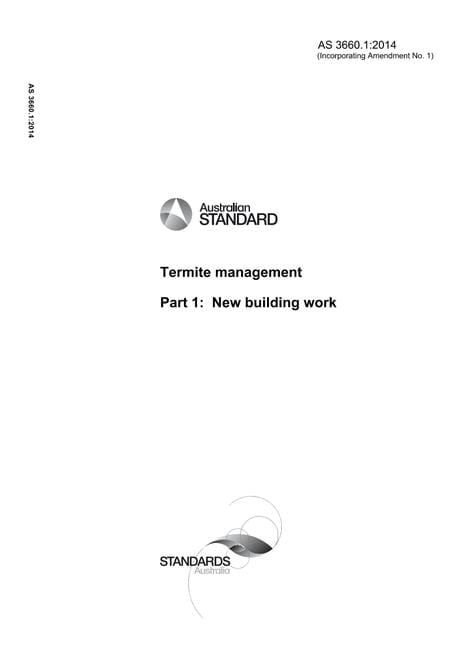
Regulatory Requirements and Standards in Australia
In Australia, termite protection is not just a matter of personal preference; it is also governed by regulations and standards designed to safeguard homes from the significant damage termites can cause. Understanding and complying with these standards is important for homeowners and builders alike. This section will provide an overview of the relevant regulations and offer tips on how to ensure compliance during the construction and maintenance of termite barriers.
Relevant Australian Standards
AS 3660.1:2014 - Termite Management for New Building Work
- Overview: This standard provides guidelines for termite management in new building work, including the installation of physical and chemical barriers. It outlines the performance requirements for these systems, ensuring they are designed to prevent concealed entry by termites.
- Key Requirements:
- Barrier Installation: The standard specifies how barriers should be installed to meet performance criteria, including depth, placement, and integration with the building structure.
- Inspection Zones: AS 3660.1 also mandates the creation of inspection zones where termite activity can be easily monitored, typically around the perimeter of the building.
- Documentation: Builders must provide detailed documentation of the termite management system installed, including product specifications and maintenance requirements.
AS 3660.2:2017 - Termite Management in Existing Buildings
- Overview: This standard covers termite management in existing buildings, focusing on the installation of barriers in structures that were not originally equipped with them. It provides guidance on retrofitting barriers and maintaining their effectiveness over time.
- Key Requirements:
- Barrier Retrofitting: The standard outlines procedures for retrofitting both physical and chemical barriers in existing buildings, ensuring they meet the same performance criteria as new installations.
- Inspection and Maintenance: Regular inspections and maintenance are emphasised to ensure that retrofitted systems remain effective against termite intrusion.
- Compliance Documentation: Similar to new building work, documentation of the termite management system, including maintenance schedules and inspection records, is required.
National Construction Code of Australia (NCC)
- Overview: The NCC incorporates the Australian Standards for termite management and specifies the minimum requirements for termite protection in new residential buildings.
- Key Requirements:
- Compliance with AS 3660: The NCC mandates that all new residential buildings must comply with AS 3660.1 for termite management.
- Structural Integrity: The NCC ensures that termite management systems do not compromise the structural integrity of the building and are integrated into the overall building design.
Compliance Tips for Builders and Homeowners
For Builders:
- Follow Best Practices: Ensure that all termite barriers are installed in accordance with AS 3660.1 or AS 3660.2, as applicable. This includes proper placement, integration with the building structure, and creation of inspection zones.
- Provide Comprehensive Documentation: After installation, provide homeowners with complete documentation of the termite barrier system, including maintenance schedules, product warranties, and inspection recommendations.
- Regular Training: Keep up to date with the latest standards and best practices in termite management by participating in ongoing training and certification programs.
Familiarise
- Understand Your System: Familiarise yourself with the termite barrier system installed in your home. Ensure you have all the necessary documentation, including maintenance schedules and inspection requirements.
- Schedule Regular Inspections: Adhere to the recommended inspection schedule to ensure your termite barrier system remains effective. Consider hiring a licensed pest control professional for these inspections.
- Keep Records: Maintain records of all inspections, maintenance, and any treatments applied to your termite barrier system. This can be crucial if you ever need to make a claim under warranty or if you sell your home.
- Cost Considerations
When it comes to termite protection, cost is an important factor for both homeowners and builders. While investing in a reliable termite barrier system can involve significant upfront expenses, the potential savings in terms of avoiding costly repairs and preserving property value often make it a wise financial decision. This section will explore the various cost considerations associated with installing and maintaining termite barrier systems, helping you budget effectively for this crucial aspect of home protection.
Initial Costs vs. Long-Term Savings
Initial Costs:
- Physical Barriers: Physical barriers such as stainless steel mesh, graded stone/glass, and polymeric sheets can vary widely in cost depending on the materials used and the complexity of the installation. Stainless steel mesh systems, for example, tend to be more expensive due to the cost of materials and the need for professional installation.
- Chemical Barriers: The installation of chemical barriers, particularly reticulated systems, involves costs for both the materials (termiticide and piping) and the labour required for installation. While the initial costs may be lower than some physical barriers, ongoing maintenance must be factored in.
- Combination Systems: Combining physical and chemical barriers often results in higher initial costs due to the integration of multiple systems. However, this approach can provide enhanced protection, potentially reducing the need for future repairs or additional treatments.
Long-Term Savings:
- Prevention of Damage: The most significant long-term savings from installing termite barriers come from preventing the extensive damage that termites can cause. Structural repairs due to termite damage can easily run into tens of thousands of dollars, far exceeding the cost of a barrier system.
- Reduced Maintenance Costs: High-quality physical barriers require minimal maintenance once installed, reducing ongoing costs. Chemical barriers may require periodic recharging, but this cost is generally lower than the potential costs of termite damage.
- Property Value Preservation: Homes with effective termite protection are likely to retain their value better over time. In some cases, having a reliable termite barrier system in place can even increase a property's resale value, as it provides prospective buyers with added peace of mind.
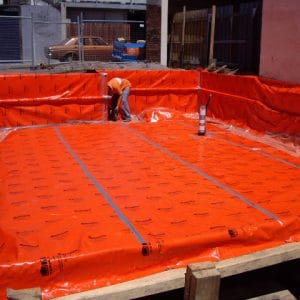
Budgeting for Termite Protection
For New Constructions:
- Include Termite Protection in the Initial Budget: When planning a new construction project, it’s essential to allocate funds for termite protection from the outset. This should include both the installation of barriers and any necessary inspections.
- Consider Long-Term Costs: While it might be tempting to choose a less expensive barrier system, consider the long-term costs and benefits. Investing in a higher-quality system now can save money in the long run by preventing costly damage and reducing maintenance needs.
For Existing Homes:
- Evaluate the Current Risk Level: If you’re retrofitting a termite barrier system in an existing home, assess the level of termite risk in your area. Homes in high-risk areas may justify a higher investment in a robust barrier system.
- Plan for Maintenance: Include the cost of regular inspections and maintenance in your annual home maintenance budget. For chemical barriers, plan for periodic recharging of the system, which is essential to maintain its effectiveness.
Financing Options:
- Home Improvement Loans: Some homeowners may choose to finance the installation of a termite barrier system through a home improvement loan. This can spread the cost over time, making it more manageable.
- Insurance Considerations: While most standard home insurance policies do not cover termite damage, some policies may offer discounts for homes with effective termite protection in place. Check with your insurance provider to see if this applies to your situation.
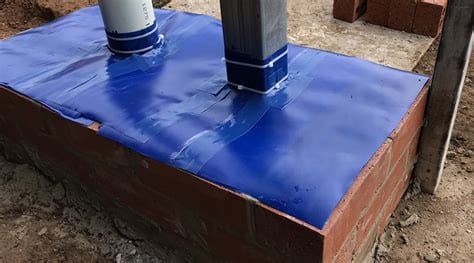
Conclusion
As we’ve explored throughout this blog post, termite protection is a critical aspect of maintaining the structural integrity and value of your home. Australia’s climate and environment make termite infestations a common and costly problem, which underscores the importance of choosing the right termite barrier system when building or renovating your home.
Summary of article key points:
- Types of Barriers: We discussed several types of termite barrier systems, including physical barriers like stainless steel mesh, graded stone, polymeric sheets, and concrete slabs, as well as chemical barriers such as chemical impregnated barriers and the reticulated chemical system. Each of these systems has its unique advantages, disadvantages, and ideal application areas.
- Pros and Cons: Understanding the pros and cons of each barrier type is crucial in selecting the right protection for your home. Physical barriers offer long-term, low-maintenance protection, while chemical barriers provide high effectiveness and flexibility but require ongoing maintenance.
- Application Areas: The suitability of different termite barriers varies depending on whether your home is in an urban or rural area, and whether it’s located in a high-risk region for termite activity. Combining physical and chemical barriers can offer enhanced protection, particularly in areas with severe termite threats.
- Maintenance: Regular inspections and maintenance are vital to ensuring that your termite barrier system remains effective. By following best practices and staying vigilant, homeowners can protect their homes from termites for the long term.
- Regulatory Compliance: Adhering to Australian standards for termite protection is not only a legal requirement but also ensures that your home is properly safeguarded against termite damage. Both builders and homeowners should be familiar with these standards and ensure compliance during construction and maintenance.
- Cost Considerations: While termite barrier systems represent a significant investment, the long-term savings from preventing termite damage far outweigh the initial costs. Proper budgeting and planning can help make this investment more manageable.
Final Thoughts
Investing in a high-quality termite barrier system is one of the best ways to protect your home from the devastating effects of termites. Whether you’re building a new home or looking to protect an existing property, the right barrier system, combined with regular maintenance and inspections, can provide peace of mind and long-term savings.
Remember, the best time to think about termite protection is before you see any signs of termites. Proactive measures are always more effective—and less costly—than dealing with an infestation after it’s already taken hold.
Frequently Asked Questions (FAQs)
This section addresses common questions that homeowners and builders might have about termite barrier systems. Providing clear answers to these questions can help demystify the process and offer additional guidance.
1. What are the most effective termite barriers?
- Answer: The most effective termite barriers depend on the specific needs of your home. Physical barriers like stainless steel mesh and concrete slabs provide long-lasting protection with minimal maintenance, while chemical barriers, such as reticulated systems, offer high effectiveness and flexibility. A combination of both is often the most comprehensive approach.
2. How do I know which termite barrier is right for my home?
- Answer: Choosing the right termite barrier involves assessing your home's risk level, location, and construction type. For high-risk areas or existing homes, a reticulated chemical system might be ideal, while new constructions may benefit from physical barriers like stainless steel mesh or graded stone. Consulting with a pest control professional can help you make the best choice.
3. Can termite barriers be used in existing homes?
- Answer: Yes, many termite barrier systems can be retrofitted into existing homes. Chemical barriers, especially reticulated systems, are particularly well-suited for existing structures. Physical barriers can also be added during renovations, though this may require more extensive work.
4. How often should I inspect my termite barriers?
- Answer: It's recommended to have your termite barriers inspected at least once a year by a licensed pest control professional. Regular inspections ensure that the barriers remain effective and can identify any potential issues before they become serious problems.
5. What are the signs that my termite barrier needs maintenance?
- Answer: Signs that your termite barrier might need maintenance include visible damage to physical barriers (such as cracks in concrete slabs or tears in polymeric sheets) and reduced effectiveness in chemical barriers (e.g., termites bypassing the barrier). Regular inspections can help catch these issues early.
6. Is it necessary to use other termite control methods alongside barriers?
- Answer: While termite barriers provide a strong line of defense, combining them with other methods, such as bait stations or soil treatments, can enhance protection. This is especially important in high-risk areas where termites are particularly aggressive.
7. How do I ensure compliance with Australian standards for termite protection?
- Answer: To ensure compliance, work with licensed professionals who are familiar with AS 3660.1 and AS 3660.2 standards. These professionals should provide documentation of the termite barrier system, including details on installation, maintenance, and inspection schedules.
8. Are there environmentally friendly termite barrier options?
- Answer: Yes, physical barriers like stainless steel mesh and graded stone are environmentally friendly options that do not involve chemicals. These barriers are effective and long-lasting, making them a good choice for eco-conscious homeowners.
9. What should I do if I find termites despite having a barrier?
- Answer: If you find termites in your home despite having a barrier, contact a licensed pest control professional immediately. They can assess the situation, determine how the termites bypassed the barrier, and recommend the best course of action to eliminate the infestation and reinforce the barrier.
10. How can I budget for termite protection in a new construction project?
- Answer: When budgeting for termite protection in a new construction project, include the costs of both the barrier system and regular inspections in your overall budget. Consider the long-term savings of preventing termite damage when deciding on the level of investment.
Further Reading
For those looking to learn more about termite protection and related topics, we recommend the following articles available on our blog:

